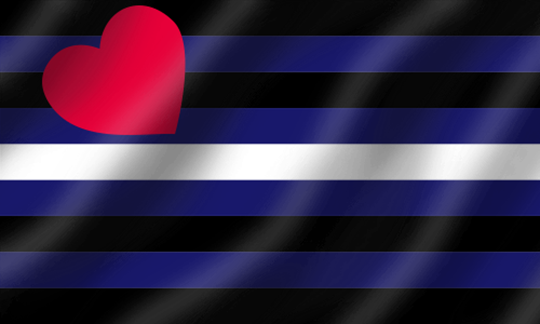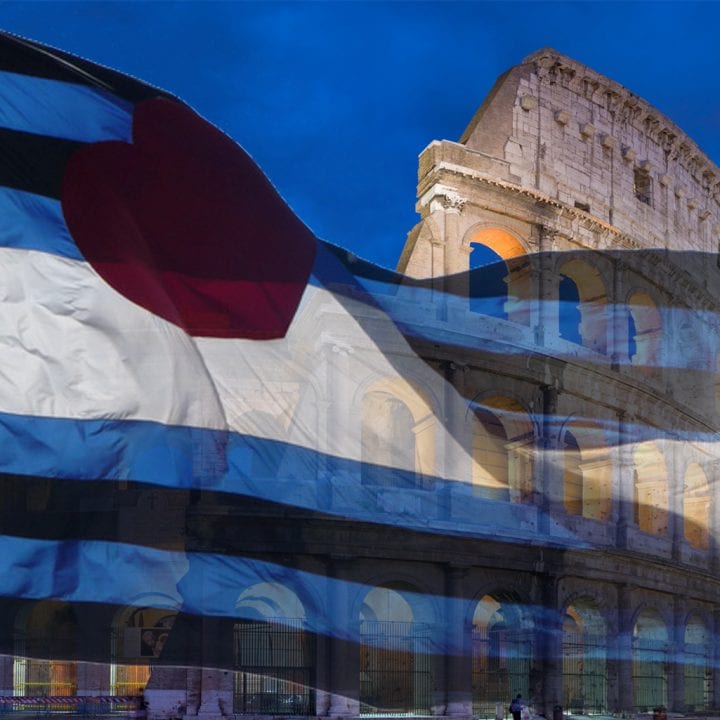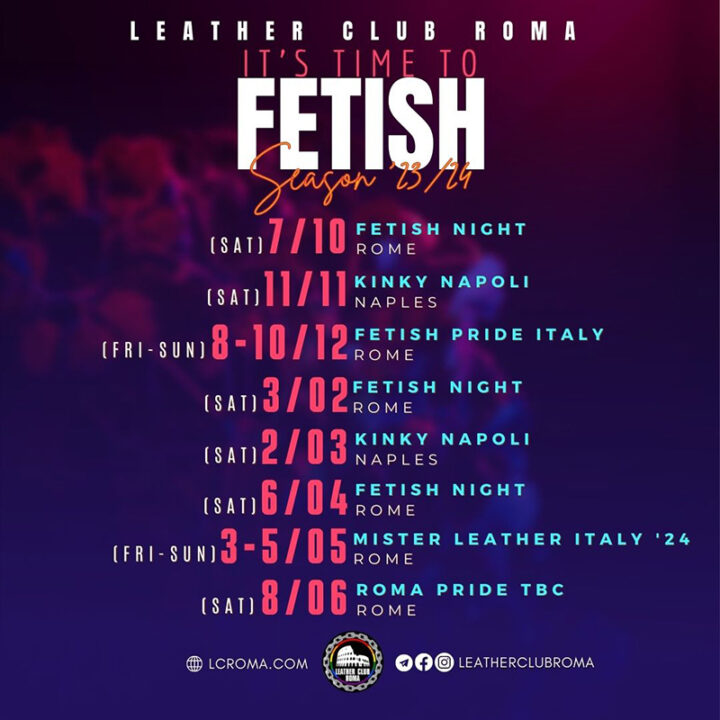A comprehensive (and annotated) list of all LGBTQ+ flags
The Rainbow pride flag

The Rainbow flag is the symbol of the LGBTQI+ community: it represents the entire community as a whole and is widely known (even outside the LGBTQI+ community). In fact, the rainbow has become, over the years, the symbolic color of the community, used both in the Rainbow Flag (and its variants) and in objects and clothing.
Its diffusion is almost universal: the MOMA in New York has included it in its collection and n and homophobic states such as Saudi Arabia even prevent the sale of objects and clothing with rainbow colors..
The flag was created in 1978 by Gilbert Baker, after Harvey Milk asked him to think of a symbol for the LGBTQI+ community: up to that moment, in fact, the symbol used was that of the Pink Triangle, which however evoked the terrible persecutions of the Nazi period. Gilbert Baker chose a flag as a symbol also influenced by the wide use of US flags in 1976 (bicentenary of the birth of the USA).
The flag was used for the first time on June 26, 1978 during the San Francisco Gay Freedom Day parade; its diffusion as a universal symbol of the LGBTQI+ community can be traced back to 1994, when Gilbert Baker created a mile-long version to commemorate the twenty-fifth anniversary of the Stonewall riots.
The colors of the rainbow (each of which originally had its own meaning) represent the many facets of the LGBTIQ+ community.
Note: originally the colors of the flag were 8 (there was a pink stripe before the red and a turquoise one before the blue); they were reduced to six in the first years of use of the flag mainly due to the difficulty of finding pink and turquoise cloth on the market..
Varianti

Progress Pride Flag
The Progress Pride Flag was created in 2017 by US non-binary artist Daniel Quasar. The design of the flag is based on that of the rainbow flag with the addition of elements of the Transgender flag (pink, blue, white) and brown and black stripes in honor of black people.
It has had wide diffusion in the United States and, more recently, also in Europe.

Inclusive Progress Pride Flag
It was created in 2021 by Valentino Vellecchi, an intersex designer.
The design of the flag follows that of the Progress Pride Flag with the addition of elements of the Intesex flag (purple circle on a yellow background)
Widely circulated pride flags

Trans pride flag
A transgender person is someone whose gender identity does not match the gender assigned at birth.
The Trans flag was created by Monica Helms (an American transgender woman) and used for the first time in 2000 during the 2000 Phoenix Pride Parade. The original flag was purchased and displayed in 2014 by the Smithsonian National Museum of American History in Washington DC.

Intersex pride flag
An intersex person is a person who presents, at birth, sexual characteristics (primary and/or secondary) that cannot be exclusively defined as male or female.
The flag was designed in 2013 by Morgan Carpenter, an Australian transgender activist and bioethicist. Carpenter chose the colors yellow and purple because neither of these colors represents the traditional constructs of binary identities.

Bisexual pride flag
A bisexual person is someone who experiences attraction (emotional, romantic, and/or sexual) to both men and women.
The flag was created by Micheal Page (a bisexual activist from Florida) in 1998 and used for the first time in 1999 at "Equality Begins at Home" in Tallahassee, Florida.
The leather & fetish pride flags

The leather pride flag
The leather pride flag represents the community of leather fetishists: it is the best-known and most widespread fetish flag and, over time, has often become the symbol of the entire LGBTIQ+ fetish community.
The leather pride flag was created in 1989 by Tony DeBlase (a known American activist who died in 2000 who was, among other things, also a writer and editor of the famous Drummer magazine).
The flag was created on the occasion of the twentieth anniversary of the Stonewall riots and presented on May 28, 1989, during the International Mister Leather in Chicago.
The leather pride flag immediately gained wide diffusion: already in December 1989 some gadgets with the colors of the leather flag appeared, it conquered the cover of Drummer in 1991; it was used -always starting from 1991- for the sash of Mister Leather International and its colors were widely used in the logos of the associations and clubs of the leather community. It is known, and used, even outside the LGBTIQ+ community.
Other well-known fetish pride flags

Rubber pride flag
It is probably the best known together with the leather flag.
It was created by Peter Tolos and Scott Moats in 1994

Puppy pride flag
Although it is quite recent (2011) it is spreading widely. The original design (by Jeff Hull - Grungepup Jeff) had a doberman head in the center, later replaced with bone by Pup Flip Gray).

BDSM Pride Flag
This flag (whose design probably dates back to 2005) is widespread in both the LGBTQI+ BDSM and heterosexual communities (indeed, perhaps more in the latter).
More pride flags
LGBTIQ+ flags have seen a significant increase in recent decades: each community or group has created its own as identity, recognition, and visibility tool. Below is a complete list (almost) of all known flags with some explanation.

Pansexual pride flag
Pansexuals feel attraction to an individual regardless of the sex or gender. The flag dates from 2010.

Non-Binary pride flag
Non-binary people are those whose gender identity is not exclusively male or female. The flag was created in 2014 by Kyle Rowan.

Gender-Fluid pride flag
A gender-fluid person does not have a fixed gender identity over time. The flag was created by JJ Pole in 2012.

Asexual Pride Flag
An asexual person is a person who does not experience sexual attraction to other individuals. The flag was created in 2010 by Aven (Asexual visibility and education network).

Lesbian pride flag
It is probably the most widespread and well-known flag of lesbian women; It was created in 2018 by (Tumblr) blogger Emily Gwen.

Gay men pride flag
Not a widespread flag (and it replaces a previous one which had different shades of blue). Created in 2019 by a Tumblr user (gayflagblog) it represents all gay men (cis, trans, non-binary, etc.)

Polysexual pride flag
A polysexual person is someone who experiences sexual and/or romantic attraction to individuals of multiple genders (but not all, unlike pansexuals). The flag was created in 2012 by Tumblr user Tomlin

Straight Ally Flag
A"straight ally" is a person who does not belong to the LGBTIQ+ community who supports their requests and claims. The flag was created in 2000 by combining the colors of the rainbow flag and those of the heterosexual flag.

Bear Pride Flag
The word bear means a robust and hairy gay man, usually with a masculine appearance. The flag was created in 1995 by Craig Byrnes and is quite widespread and well known

Military Fetish Pride Flag
Inspired by the colors of camouflage, this flag represents all those with a fetish for military uniforms; the creator is unknown. It's not very common.

SkinHead Fetish Pride Flag
This flag, which represents all those with a Skinhead clothing fetish, was created in 2006 by SkinDavid and Shadowskin (from Antwerp) for the 10th anniversary of the FENIX Global Skin Movement.

Master - Slave pride flag
Designed in 2005 by Master Tallen (Washington, DC) the flag brings together those who are attracted to master-slave type relationships. It is not widespread and is also used outside the LGBTIQ+ community

Aromatic pride flag
Aromantic individuals (sometimes abbreviated to Aro) do not have the innate desire to be in a romantic relationship with other individuals. The romantic flag has (had) many versions; this is probably the most popular (drawn in 2014 by user Cameron on Tumblr)

GenderQueer pride flag
A genderqueer person does not adhere to conventional gender distinctions, but still identifies with both, neither, or a combination of male and female genders. The term genderqueer is similar to non-binary, but has a broader meaning that includes any identity that is not cisgender. The flag was designed in 2011 by Marilyn Roxie.

Androgynous pride flag
An androgynous person is someone who displays a combination of masculine and feminine characteristics in an ambiguous form. The flag was created in 2014 by Tumblr user saveferris.

Agender pride flag
An agender person is a person who does not identify as belonging to a specific gender and who refers to himself as an individual. The flag was created in 2014 by Salem X.

Lesbian Flag (Labrys)
Designed by Arisa Berria in 1978, it shows the double ax of the Amazons (labrys) as a symbol of female power. This is a flag often used by lesbian (or feminist) groups that do not accept trans women.

Lesbian Flag (Butch)
The word "butch" denotes a woman whose expression and gender traits are typically "masculine" (thus challenging traditional binary male and female gender roles and expressions). The flag was designed by Tumblr user Butchspace in 2017

Demisexaul pride flag
A demisexual person experiences sexual attraction to another person only in the presence of a strong romantic connection; for demisexuals, romantic attraction always precedes sexual attraction.

Demiromantic pride flag
Demiromantic (sometimes greyromantic) individuals experience romantic attraction/fall in love with other people only if (and after) a strong emotional connection is present.

Polyamorous pride flag
The polyamorous community includes those people who form romantic and sexual relationships with multiple people at the same time. It is an ethical and consensual form of non-monogamy. This flag was designed by Jim Evans in 1995 (however, there are other flags of the polyamorous community as well).

Abrosexual pride flag
An abrosexual person has a fluid sexual orientation and can experience different sexual orientations over time (without having control over that fluidity). The flag has been featured on DeviantArt and Tumblr since 2013.

Bigender pride flag
Bigender people experience exactly two gender identities, both simultaneously and fluctuating between the two. These two gender identities are often masculine and feminine, but the two genders can include non-binary identities as well

Pangender pride flag
Pangender (sometimes also omnigender) people identify themselves in a number (more than two) of separate identities; these identities can be fluid over time (varying both in type and intensity) or give rise to a stable all-encompassing identity.
Altre bandiere e approfondimenti
The list doesn't really end there... There are other flags, as well as other gender identities and sexual and romantic orientations beyond the ones we have indicated.
Further reading
- A rather detailed list with extensive explanations of the various flags found on QueerIntheWorld;
- Interesting insights into gender identities and sexual and romantic orientations can be found at:
- A broader look, including frequently updated news, on the world of sexual diversity can be found at SexualDiversity.org
The rainbow flag is probably the best known of the LGBTIQ+ flags; however, there are many others – more or less widespread – that express the pride of the multiple communities gathered behind the acronym LGBTIQ+: from the bisexual community to the transsexual one, from the aromantic to the intersex one, without forgetting the flags of the fetish communities (leather, rubber, puppies, etc.).




